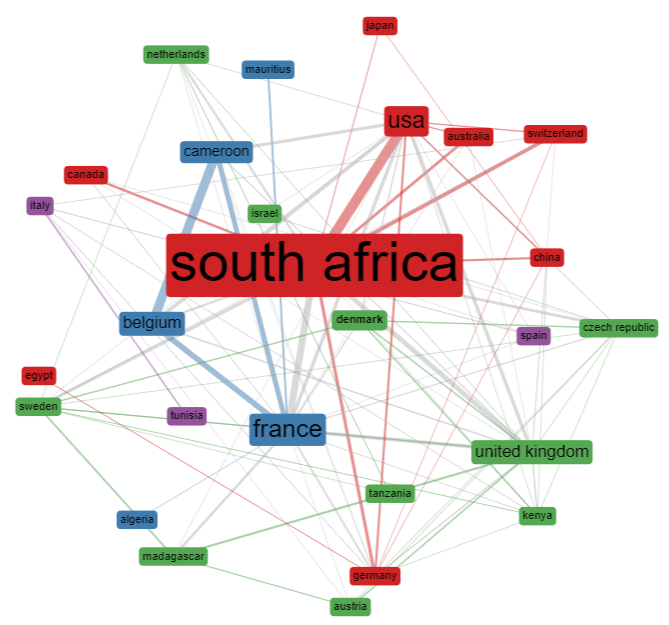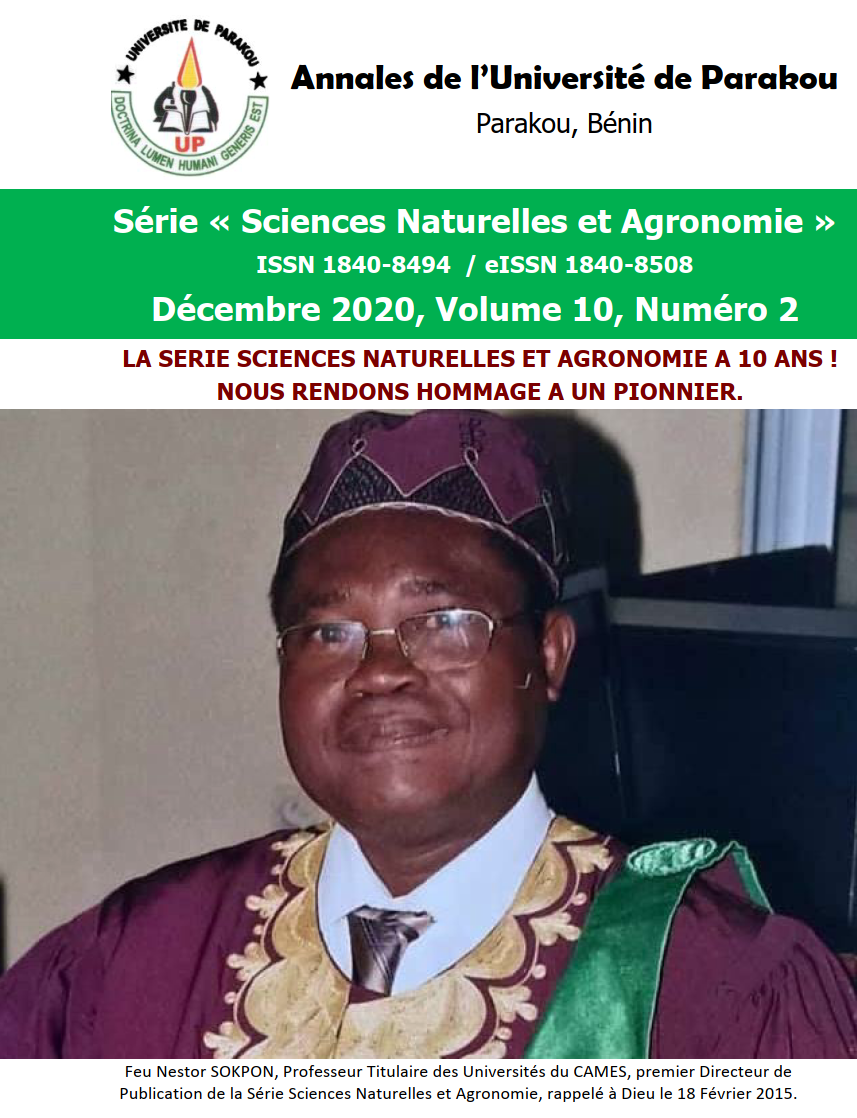Research trends and perspectives on African orchids: a bibliometric overview
DOI :
https://doi.org/10.56109/aup-sna.v11i1.29Mots-clés :
Orchids, research trend, priority research topics, AfricaRésumé
Worldwide scientific publications on the remarkably diverse Orchidaceae family are comprehensive, but Africa's craze for the taxon was only felt a few decades ago. This largest and threatened family of flowering plants is widely distributed in tropical areas and recognized by several authors for its environmental, ornamental, and medicinal importance. This review aims to identify research patterns on African orchids using co-citation analysis and bibliometric information visualization. 386 publications concerning African orchids listed in the Scopus database from 1968 to May 2020 were recorded and reviewed. The description of new orchid taxa, the adaptation of orchids to various pollinators and phylogeny emerged as the most discussed aspects. In total, 889 authors have invested in research on orchids in Africa. Johnson Steven D. was the most impactful author with h-index 37. Interestingly, several institutions were involved in these studies with a large dominance of the University of KwaZulu-Natal, a South African University. Future research efforts should target the identification of new orchid species and emphasize on orchid distribution, ecology, and species’ threats. They should also focus on developing efficient management and domestication strategies for orchid species to reduce threats to this family. The restoration and conservation planning of degraded orchid habitats are additional avenues to be explored by future research.
Téléchargements
Métriques
Références
Acharya K. P. and Rokaya M. B. 2010. Medicinal orchids of Nepal: are they well protected?, Our Nature, 8 (1), pp. 82–91. doi:10.3126/on.v8i1.4315 DOI: https://doi.org/10.3126/on.v8i1.4315
Ansoms A. and Marysse S. 2011. Natural Resources and Local Livelihoods in the Great Lakes Region of Africa. Springer. doi:10.1057/9780230304994 DOI: https://doi.org/10.1057/9780230304994
Aria, M. and Cuccurullo, C. (2017) bibliometrix: An R-tool for comprehensive science mapping analysis, Journal of Informetrics, 11(4), pp 959-975. https://www.bibliometrix.org DOI: https://doi.org/10.1016/j.joi.2017.08.007
Assédé E. S. P., Azihou A. F., Geldenhuys C. J., Chirwa P. W. and Biaou S. S. H. 2020. Sudanian versus Zambezian woodlands of Africa: Composition, ecology, biogeography and use, Acta Oecologica, 107, pp. 103599. doi:10.1016/j.actao.2020.103599 DOI: https://doi.org/10.1016/j.actao.2020.103599
Assèdé E. S. P., Djagoun C. A. M. S., Azihou A. F., Kouton M. D., Gogan Y. S. C., Geldenhuys C. J., Chirwa P. W. and Sinsin B. A. 2017. Folk perceptions and patterns of use of orchid species in Benin, West Africa, Flora et Vegetation Sudano-Sambesica, 20, pp. 26–36. DOI: https://doi.org/10.21248/fvss.20.48
Assèdé E. S. P., Djagoun C. A. M. S., Azihou F. A., Gogan Y. S. C., Kouton M. D., Adomou A. C., Geldenhuys C. J., Chirwa P. W. and Sinsin B. 2018. Efficiency of conservation areas to protect orchid species in Benin, West Africa, South African Journal of Botany, 116, pp. 230–237. doi:10.1016/j.sajb.2018.02.405 DOI: https://doi.org/10.1016/j.sajb.2018.02.405
Balducci M. G., Van der Niet T. and Johnson S. D. 2019. Butterfly pollination of Bonatea cassidea (Orchidaceae): Solving a puzzle from the Darwin era, South African Journal of Botany, 123, pp. 308–316. doi:10.1016/j.sajb.2019.03.030 DOI: https://doi.org/10.1016/j.sajb.2019.03.030
Bhattacharyya P. and van Staden J. 2018. Molecular insights into genetic diversity and population dynamics of five medicinal Eulophia species: a threatened orchid taxa of Africa, Physiology and Molecular Biology of Plants, 24 (4), pp. 631–641. doi:10.1007/s12298-018-0523-6 DOI: https://doi.org/10.1007/s12298-018-0523-6
Bolus H. F. L. S. 1888. The orchids of the Cape Peninsula. South African Philosophical Society. V. Cape Town: The Society. DOI: https://doi.org/10.5962/bhl.title.15383
Boukehili K., Boutabia L., Telailia S., Menaa M., Tlidjane A., Maazi M. C., Chefrour A., Saheb M. and Véla E. 2018. Les orchidées de la région de Souk-Ahras (Nord-est algérien): inventaire, écologie, répartition et enjeux de conservation, Revue d’écologie. DOI: https://doi.org/10.3406/revec.2018.1924
Castro J. B. and Singer R. B. 2019. A literature review of the pollination strategies and breeding systems in Oncidiinae orchids, Acta Botanica Brasilica, 33 (4), pp. 618–643. doi:10.1590/0102-33062019abb0111 DOI: https://doi.org/10.1590/0102-33062019abb0111
Chimi D. C., Nfornkah B. N., Kabelong, B. L. P. R., Noudem J. C., Misse A. C., Tabue M. R. B., et al. 2020. Orchids diversity and biomass on a native host tree species in a semi-deciduous rain forest of Cameroon, Journal of Sustainable Forestry, pp. 1–12. doi:10.1080/10549811.2020.1746350 DOI: https://doi.org/10.1080/10549811.2020.1746350
Chinsamy M., Finnie J. F. and Van Staden J. 2011. The ethnobotany of South African medicinal orchids, South African Journal of Botany, 77 (1), pp. 2–9. doi:10.1016/j.sajb.2010.09.015 DOI: https://doi.org/10.1016/j.sajb.2010.09.015
CITES 2020. Appendices I, II and III. Available from: https://cites.org/sites/default/files/eng/app/2020/E-Appendices-2020-08-28.pdf
Cozzolino S. and Widmer A. 2005. Orchid diversity: an evolutionary consequence of deception?, Trends in Ecology & Evolution, 20 (9), pp. 487–494. doi:10.1016/j.tree.2005.06.004 DOI: https://doi.org/10.1016/j.tree.2005.06.004
Dearnaley J. D., Martos F. and Selosse M.-A. 2012. 12 orchid mycorrhizas: molecular ecology, physiology, evolution and conservation aspects, in: Fungal associations. Springer, pp. 207–230. DOI: https://doi.org/10.1007/978-3-642-30826-0_12
Djalante R. 2018. A systematic literature review of research trends and authorships on natural hazards, disasters, risk reduction and climate change in Indonesia., Natural Hazards & Earth System Sciences, 18 (6). doi:10.5194/nhess-18-1785-2018 DOI: https://doi.org/10.5194/nhess-18-1785-2018
Droissart V., Cribb P. J., Simo-Droissart M. and Stévart T. 2014. Taxonomy of Atlantic Central African orchids 2. A second species of the rare genus Distylodon (Orchidaceae, Angraecinae) collected in Cameroon, PhytoKeys, (36), pp. 27. doi:10.3897/phytokeys.36.7225 DOI: https://doi.org/10.3897/phytokeys.36.7225
Droissart V., Sonké B. and Stévart T. 2006. The Orchidaceae endemic to Atlantic Central Africa occurring in Cameroon, Systematics and Geography of Plants, 76 (1), pp. 3–84.
Fay M. F. 2018. Orchid conservation: how can we meet the challenges in the twenty-first century?, Botanical Studies, 59 (1), pp. 16. doi:10.1186/s40529-018-0232-z DOI: https://doi.org/10.1186/s40529-018-0232-z
Fetscherin M., Voss H. and Gugler P. 2010. 30 Years of foreign direct investment to China: An interdisciplinary literature review, International Business Review, 19 (3), pp. 235–246. doi:10.1016/j.ibusrev.2009.12.002 DOI: https://doi.org/10.1016/j.ibusrev.2009.12.002
Fonge B. A., Essomo S. E., Bechem T. E., Tabot P. T., Arrey B. D., Afanga Y. and Assoua E. M. 2019. Market trends and ethnobotany of orchids of Mount Cameroon, Journal of Ethnobiology and Ethnomedicine, 15 (1), pp. 29. doi:10.1186/s13002-019-0308-1 DOI: https://doi.org/10.1186/s13002-019-0308-1
Franklin J. F., Mitchell R. J. and Palik B. J. 2007. Natural disturbance and stand development principles for ecological forestry, Gen. Tech. Rep. NRS-19. Newtown Square, PA: US Department of Agriculture, Forest Service, Northern Research Station. 44 p., 19. doi:10.2737/NRS-GTR-19 DOI: https://doi.org/10.2737/NRS-GTR-19
Grobler L. 2005. Conservation in South Africa: An Orchidist’s Perspective, Selbyana, pp. 81–84.
Gutiérrez R. M. P. 2010. Orchids: A review of uses in traditional medicine, its phytochemistry and pharmacology, Journal of Medicinal Plants Research, 4 (8), pp. 592–638. doi:10.5897/JMPR DOI: https://doi.org/10.5897/JMPR
IUCN 2017. The IUCN Red List of Threatened Species, Version 2019-2.
Jecmenica V., Droissart V., Akouangou E., Nyangala C., Bakita B., Biteau J. P. and Stévart T. 2017. Taxonomy of Atlantic Central African orchids, 6: Three new species of Angraecum sect. Afrangraecum (Orchidaceae, Angraecinae) from Gabon and Sao Tomé, Phytotaxa, 323 (2), pp. 143–158. DOI: https://doi.org/10.11646/phytotaxa.323.2.3
Jersakova J. and Johnson S. D. 2006. Lack of floral nectar reduces self-pollination in a fly-pollinated orchid, Oecologia, 147 (1), pp. 60–68. doi:10.1007/s00442-005-0254-6 DOI: https://doi.org/10.1007/s00442-005-0254-6
Kasulo V., Mwabumba L. and Cry M. 2009. A review of edible orchids in Malawi, Journal of Horticulture and Forestry, 1 (7), pp. 133–139. doi:10.5897/JHF.9000003
Kendon J. P., Rajaovelona L., Sandford H., Fang R., Bell J. and Sarasan V. 2017. Collecting near mature and immature orchid seeds for ex situ conservation:‘in vitro collecting’as a case study, Botanical Studies, 58 (1), pp. 34. doi:10.1186/s40529-017-0187-5 DOI: https://doi.org/10.1186/s40529-017-0187-5
Leydesdorff L., de Moya-Anegón F. and Guerrero-Bote V. P. 2010. Journal maps on the basis of Scopus data: A comparison with the Journal Citation Reports of the ISI, Journal of the American Society for Information Science and Technology, 61 (2), pp. 352–369. doi:10.1002/asi.21250 DOI: https://doi.org/10.1002/asi.21250
Linder H. P. 1995. Setting conservation priorities: the importance of endemism and phylogeny in the southern African orchid genus Herschelia, Conservation Biology, 9 (3), pp. 585–595. doi:10.1046/j.1523-1739.1995.09030585. x DOI: https://doi.org/10.1046/j.1523-1739.1995.09030585.x
Linder H. P., Kurzweil H. and Johnson S. D. 2005. The Southern African orchid flora: composition, sources and endemism, Journal of Biogeography, 32 (1), pp. 29–47. doi:10.1111/j.1365-2699.2004.01202. x DOI: https://doi.org/10.1111/j.1365-2699.2004.01202.x
Liu H. and Gao J. 2020. Orchid Conservation Translocation Efforts in China, in: Conservation and Reintroduction of Rare and Endangered Plants in China. Springer, pp. 205–224. doi:10.1007/978-981-15-5301-1_19 DOI: https://doi.org/10.1007/978-981-15-5301-1_19
Micheneau C., Johnson S. D. and Fay M. F. 2009. Orchid pollination: from Darwin to the present day, Botanical Journal of the Linnean Society, 161 (1), pp. 1–19. doi:10.1111/j.1095-8339.2009.00995. x DOI: https://doi.org/10.1111/j.1095-8339.2009.00995.x
Noyons E. 2001. Bibliometric mapping of science in a policy context, Scientometrics, 50 (1), pp. 83–98. doi:10.1023/a:1005694202977 DOI: https://doi.org/10.1023/A:1005694202977
Pant B. 2013. Medicinal orchids and their uses: tissue culture a potential alternative for conservation, African Journal of Plant Science, 7 (10), pp. 448–467. doi:10.5897/AJPS2013.1031 DOI: https://doi.org/10.5897/AJPS2013.1031
Peter C. I. and Johnson S. D. 2014. A pollinator shift explains floral divergence in an orchid species complex in South Africa, Annals of Botany, 113 (2), pp. 277–288. doi:10.193/aob/mct216 DOI: https://doi.org/10.1093/aob/mct216
Phillips D. P. and Bytebier B. 2020. A morphometric and molecular phylogenetic analysis of the African orchid genus Stenoglottis (Orchidaceae: Orchidoideae), Botanical Journal of the Linnean Society, 193 (3), pp. 340–362. DOI: https://doi.org/10.1093/botlinnean/boaa018
Pillon Y. and Chase M. W. 2007. Taxonomic exaggeration and its effects on orchid conservation, Conservation Biology, 21 (1), pp. 263–265. doi:10.1111/j.1523-1739.2006.00573.x DOI: https://doi.org/10.1111/j.1523-1739.2006.00573.x
Possobom C. C. F. and Machado S. R. 2017. Elaiophores: their taxonomic distribution, morphology and functions, Acta Botanica Brasilica, 31 (3), pp. 503–524. doi:10.1590/0102-33062017abb0088 ISSN1677-941X DOI: https://doi.org/10.1590/0102-33062017abb0088
Sanford W. W. and Adanlawo I. 1973. Velamen and exodermis characters of West African epiphytic orchids in relation to taxonomic grouping and habitat tolerance, Botanical Journal of the Linnean Society, 66 (4), pp. 307–321. doi:10.1111/j.1095-8339.1973.tb02178.x DOI: https://doi.org/10.1111/j.1095-8339.1973.tb02178.x
Simo-Droissart M., Stévart T., Sonké B., Mayogo S., Kamdem N. and Droissart V. 2018. New taxonomic and conservation status of Ossiculum (Vandeae, Orchidaceae), a highly threatened and narrow-endemic angraecoid orchid from Central Africa, PhytoKeys, (98), pp. 85. doi:10.3897/phytokeys.98.23511 DOI: https://doi.org/10.3897/phytokeys.98.23511
Stewart J., Linder H. P., Schelpe E. A. and Hall A. V. 1982. Wild orchids of Southern Africa. Macmillan. Johannesburg.
Subedi A., Hunwar B., Choi Y., Dai Y., Tinde van A., Chaudhary R. P., de Boe H. J. r and Gravendeel B. 2013. Collection and trade of wild-harvested orchids in Nepal | Journal of Ethnobiology and Ethnomedicine | Full Text, Journal of Ethnobiology and Ethnomedicine, 9 (64). doi:10.1186/1746-4269-9-64. DOI: https://doi.org/10.1186/1746-4269-9-64
Swarts N. D. and Dixon K. W. 2009. Terrestrial orchid conservation in the age of extinction, Annals of Botany, 104 (3), pp. 543–556. doi:10.1093/aob/mcp025 DOI: https://doi.org/10.1093/aob/mcp025
Travers S. L., Jackman T. R. and Bauer A. M. 2014. A molecular phylogeny of Afromontane dwarf geckos (Lygodactylus) reveals a single radiation and increased species diversity in a South African montane center of endemism, Molecular Phylogenetics and Evolution, 80, pp. 31–42. doi:10.1016/j.ympev.2014.07.017 DOI: https://doi.org/10.1016/j.ympev.2014.07.017
Tripathi M., Kumar S., Sonker S. K. and Babbar P. 2018. Occurrence of author keywords and keywords plus in social sciences and humanities research: A preliminary study, COLLNET Journal of Scientometrics and Information Management, 12 (2), pp. 215–232. doi:10.1080/09737766.2018.1436951 DOI: https://doi.org/10.1080/09737766.2018.1436951
Tsering J., Tam N., Tag H., Gogoi B. J. and Apang O. 2017. Medicinal orchids of Arunachal Pradesh: A review, Bulletin of Arunachal Forest Research, 32 (1 & 2), pp. 1–16.
Van der Niet T., Cozien R. J. and Johnson S. D. 2015. Experimental evidence for specialized bird pollination in the endangered South African orchid Satyrium rhodanthum and analysis of associated floral traits, Botanical Journal of the Linnean Society, 177 (1), pp. 141–150. doi:10.1111/boj.12229 DOI: https://doi.org/10.1111/boj.12229
Vereecken N. J., Streinzer M., Ayasse M., Spaethe J., Paulus H. F., Stoekl J., Cortis P. and Schiestl F. P. 2011. Integrating past and present studies on Ophrys pollination–a comment on Bradshaw et al., Botanical Journal of the Linnean Society, 165 (4), pp. 329–335. doi:10.1111/j.1095-8339.2011.01112.x DOI: https://doi.org/10.1111/j.1095-8339.2011.01112.x
Vermeulen J. J. 1987. Orchid Monographs: A Taxonomic Revision of the Continental African Bulbophyllinae. Vol. 2. Brill Archive.
Willis K. J. 2017. State of the world’s plants report-2017. Royal Botanic Gardens.
Wraith J., Norman P. and Pickering C. 2020. Orchid conservation and research: An analysis of gaps and priorities for globally Red Listed species, Ambio, pp. 1–11. doi:10.1007/s13280-019-01306-7 DOI: https://doi.org/10.1007/s13280-019-01306-7
Wraith J. and Pickering C. 2018. Quantifying anthropogenic threats to orchids using the IUCN Red List, Ambio, 47 (3), pp. 307–317. doi:10.1007/s13280-017-0964-0 DOI: https://doi.org/10.1007/s13280-017-0964-0
Wraith J. and Pickering C. 2019. A continental scale analysis of threats to orchids, Biological Conservation, 234, pp. 7–17. doi:1016/j.biocon.2019.03.015 DOI: https://doi.org/10.1016/j.biocon.2019.03.015
Zeng S., Huang W., Wu K., Zhang J., Teixeira da Silva J. A. and Duan J. 2016. In vitro propagation of Paphiopedilum orchids, Critical Reviews in Biotechnology, 36 (3), pp. 521–534. doi:10.3109/07388551.2014.993585 DOI: https://doi.org/10.3109/07388551.2014.993585
Zhang J., Yu Q., Zheng F., Long C., Lu Z. and Duan Z. 2016. Comparing keywords plus of WOS and author keywords: A case study of patient adherence research, Journal of the Association for Information Science and Technology, 67 (4), pp. 967–972. doi:10.1002/asi.23437. DOI: https://doi.org/10.1002/asi.23437

Téléchargements
Publiée
Comment citer
Numéro
Rubrique
Catégories
Licence
(c) Tous droits réservés Yasmine ABDOULAYE, Eméline ASSEDE, Honoré BIAOU, Samirath NANSOUNON, Coert GELDENHUYS 2021

Ce travail est disponible sous la licence Creative Commons Attribution 4.0 International .












